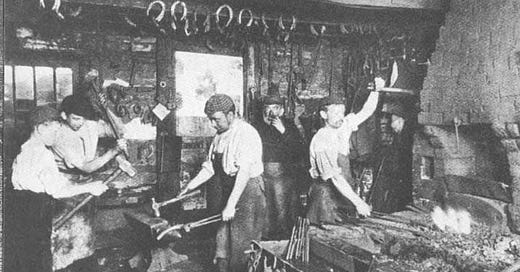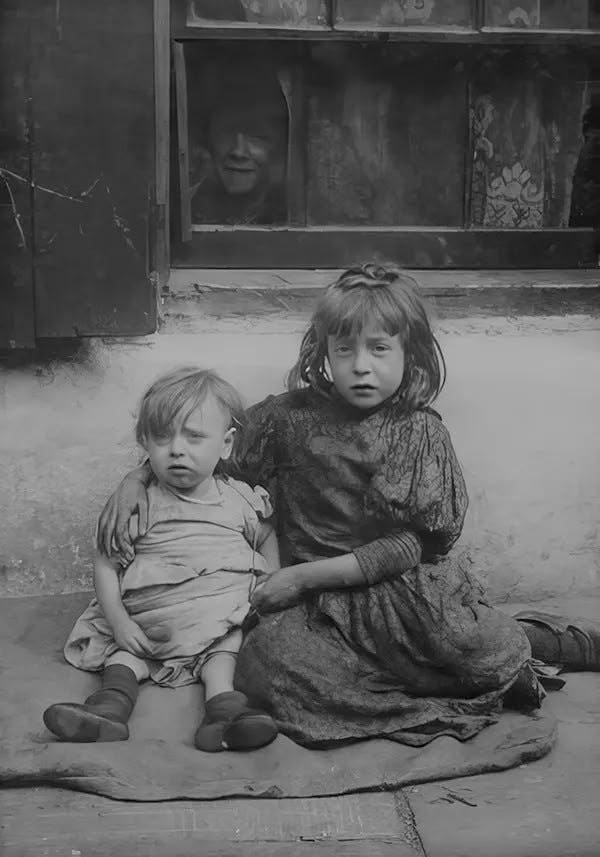Social Classes
The Victorian Era in Britain was dominated by the reign of Queen Victoria (1837-1901). Although it was a peaceful and prosperous time, there were still issues within the social structure. The social classes of this era included the Upper class, Middle class, and lower class. Those who were fortunate enough to be in the Upper class did not usually perform manual labor. Instead, they were landowners and hired lower class workers to work for them, or made investments to create a profit. This class was divided into three subcategories: Royal, those who came from a royal family, Middle Upper, important officers and lords, and Lower Upper, wealthy men and business owners.
The expansion of the Middle class during this time was due to the rapid growth of cities and the economy. It was
also referred to as the Bourgeoisie, and consisted of those who had skilled jobs to support themselves and their families. Merchants and shopkeepers became popular occupations as trade, both domestic and overseas, flourished. The large scale of new industries such as railroads, banks, and government meant that more labor was needed to make sure the cities were able to function (Loftus). The white collar professions had the ability to move up in the corporate rankings and earn a higher salary. It was helpful to have connections to those in powerful positions as they were able to get jobs more easily. Moreover, the Middle class was also divided into two categories, higher level and lower level. People from the lower middle class typically worked for those in the Higher level.
The Working class consisted of unskilled laborers who worked in brutal and unsanitary conditions. They did not have access to clean water and food, education for their children, or proper clothing. Often, they lived on the streets and were far from the work they could get, so they would have to walk to where they needed to get to. Unfortunately, many workers resorted to the use of drugs like opium and alcohol to cope with their hardships.
The Under class were those who were helpless and depended on the support of others. The poor and young orphans relied on donations to survive (Victorian England Social Hierarchy). Some women who were unskilled and could not get any jobs became prostitutes in order to make a living. As they were extremely controversial, Parliament voted to pass the “Contagious Diseases Act” (1864, 1866, 1869) which allowed prostitution in military towns, but meant the women had to be forcibly checked for diseases (Landow). The act was meant to protect the men from contracting diseases; not the women from being harmed. This mistreatment created a strong feminist movement among Victorian women who yearned for fair treatment. Finally in 1885, Parliament passed the “Criminal Law Amendment Act”, which raised the age of consent and prohibited the use of brothels.
Children-related issuues
Child Labor
During the Victorian Age, there was an early baby boom, which led to not only an increase in population, but also an advancement of industrialization. The progression of England as a society led to a greater demand for labor from both adults and children. Children took on hard-working jobs as coal miners, chimney sweepers, farm workers and domestic servants. Some children were even forced to take on the role of a railroad worker due to the invention of The Railway brought by the Industrial Revolution.
Child labor became an overarching issue in the early 1800s due to a lack of effort to improve working conditions by the upper class. Because the government was influenced by the wealthy to invest in luxury rather than promote protection for laborers, many children suffered at work. The most brutal form of child labor took place in coal mines. Children were required to work 12 to 18 hours a day in mines that were infested with rats and disease, and had poor ventilation. Such harsh working conditions led to the development respiratory problems and an increase in mine disasters/casualties.
It was not until at least thirty years later when reformers began to take action against child labor. In 1875, The New York Society for the Prevention of Cruelty to Children was founded as the first child protective agency in the world. This organization set the tone for social reform and ultimately, saved children from a life of cruelty and hardship.
Bastardy/Childcare
The term illegitimacy became popular in English society, as the population continued to expand. Many parents, especially those of the lower class, were unable to support and account for their children due to poverty and unstable marriages. It was also common for individuals to have children out of wedlock. A child was considered a “bastard” in a case where the male would leave all support and care of the child to the female. Bastardy became an issue for children-it led to an unstable home life and more importantly, limited an equal opportunity to education. As a result, the Bastardy Clause was enacted to issue “relief” for illegitimate children; however it enhanced the illegitimacy of children.
The Bastardy Clause, also known as the Poor Law Amendment Act of 1834, prohibited parishes from granting unwed mothers any relief. The law forced women and their children, without fathers, to enter workhouses that granted them a horrible reputation. However, there were some people who accepted the law as it would provide food and clothing for the poor, as well as schooling for children.
As the poor women could not afford to support their children, most chose to work as servants and lived in their employers’ homes without their children. Their wages would pay these other women, called Baby Farmers, to raise their children. The system functioned well until industrialization and urbanization led to a greater need for different kinds of paid fosterage. Mothers were determined to keep working in the city as wages were higher, but chose to keep their children in villages and towns with total strangers where conditions were safer. Unfortunately, this form of abandonment led to worsened treatment of children, and prolonged child labor.






